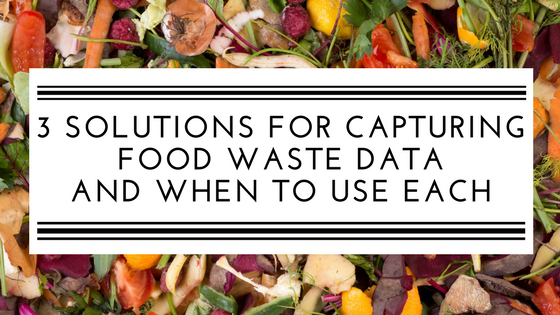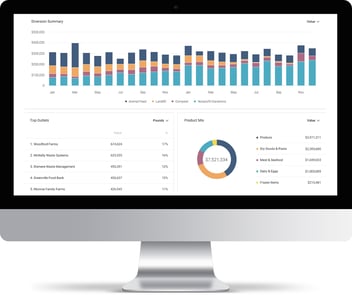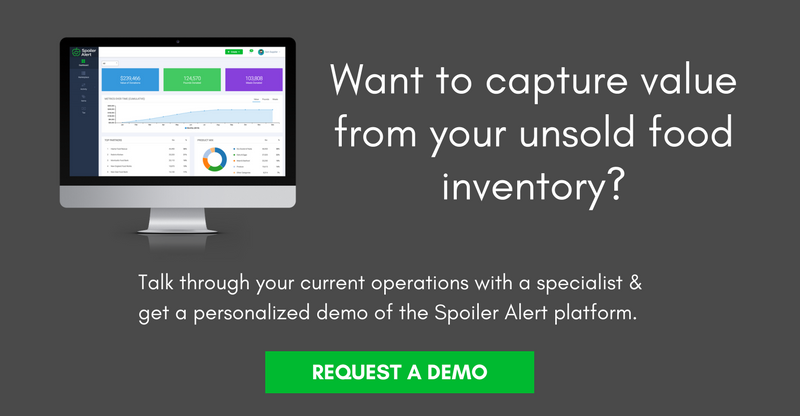
At Spoiler Alert, we’re firm believers in the value of data. We often talk about how a better understanding of data enables major food businesses to improve unsold inventory management, or how food companies can leverage data to build a business case for waste reduction. But what does this look like in practice?
To answer that question, we published a free eBook that details the essential components for developing a data-driven strategy to capture value from unsold inventory and reduce the volume of food that goes to waste. In this post, we’ll dig deeper into three solutions for capturing data, focusing on how these tools complement one another and when to employ each.
Solutions for collecting food waste data
Food businesses have several options to collect data on unsold inventory and food waste, but they differ in terms of purpose, accuracy, completeness, continuity and cost. For this reason, many food businesses leverage multiple solutions to collect data and inform different phases of their food waste reduction initiative.
The maturity of a food company’s waste reduction program, coupled with its size and scale, help determine the most appropriate and effective solution. Regardless of where a company is in the reduction process, it’s important to identify and use a consistent, credible data collection strategy that provides the actionable insights necessary to drive the initiative forward.
1. Waste audit
A waste audit is a systematic review of a facility and its operations to measure waste generation and identify activities that lead to avoidable waste. Waste audits are typically used as discovery or education tools in the early stages of a food waste reduction initiative. When implemented effectively, a waste audit provides a snapshot in time of the types and amounts of waste an organization generates, which can be extrapolated to figure out aggregated volumes over an extended period of time. Companies can then leverage the resulting data to identify purchasing and operational behaviors that lead to certain items being wasted more than others. Waste audit data is also valuable in engaging new and existing waste hauling service providers.
Waste audits help a company understand the ‘low hanging fruit’ that a reduction program can target. For example, if a company’s waste audit reveals large quantities of bagged lettuce are being trashed, they can dig into why this is happening and what can be corrected. As companies try to get more granular with the data, the volume and type of waste that a business generates may limit the effectiveness of a waste audit. Plus, since waste audits only provide a ‘snapshot in time’, they must be done regularly to monitor progress.
2. Tracking applications
Whereas waste audits provide a ‘snapshot in time’, waste tracking applications help food businesses continuously collect data to inform behavioral and operational changes. Driven by the concept, “what gets measured gets managed,” solutions provide hard data on the volume, type, and (sometimes) financial value of food that goes to waste in a distribution center or a kitchen. This enables staff to identify improvement areas and build a business case for reduction solutions. Food companies that are struggling to capture actionable insights from audits may consider investing in tracking applications to get the real-time data (such as the dates, shifts or product categories that generate waste) necessary to improve the reduction program’s effectiveness.
There are a number of for-profit companies that offer waste tracking and analytics solutions, which differ by service offering, technology, and cost. Many of America’s leading foodservice providers, including Compass Group, Aramark, and Sodexo, use waste tracking tools to drive source reduction of wasted food. Businesses often find waste tracking applications helpful in holding employees accountable for higher-than-average waste generation.
3. Management software
Management software platforms offer real-time, continuous data tracking and analytics to deliver a holistic solution for managing unsold product and reducing food waste. In a company’s warehouse or distribution center, food waste happens when unsold inventory is sent for disposal, greatly diminishing its value. Factors outside a company’s direct control often contribute to unsold inventory,, making the complete elimination of unsold products difficult. Management software provides insights like product volume, type, and quality that help inform optimal management strategies (e.g., food donation or discounted sales). Ultimately, this helps companies overcome the unsold inventory challenge and recover value from unsold product before it goes to waste.
Software solutions are also effective tools for benchmarking performance across facilities and supporting the establishment of standard operating procedures for managing unsold product. In a sense, management software combines similar measurement and tracking elements mentioned above with the functionality to immediately act on the insights produced in a consistent manner.
It is possible that a company is already capturing unsold inventory and waste data through an existing warehouse management software (WMS) or enterprise resource planning (ERP) platform. These datasets tend to be siloed or managed via spreadsheets, making it difficult to draw actionable insights that inform improved management strategies.

A screenshot of the Spoiler Alert dashboard showing Diversion Summary, Top Outlets, and Product Mix.
Spoiler Alert provides a dedicated solution for unsold inventory management, built to help companies recover value from excess stock and reduce waste. Which management solution is best will depend on existing technology, corporate commitment, annual volumes of unsold inventory and more.
From data to action...
Food waste reduction strategies that create operational and financial benefits are driven by data, and there’s a range of solutions available to help. Understanding where a company is in its waste reduction program, and what data will help move the program forward, is essential for identifying the most effective data capture solution.
Ready to find the right solution for your business? Request a demo of Spoiler Alert today!
.png?width=250&name=SpoilerAlert_WhiteLogo_LeftStacked%20(7).png)
